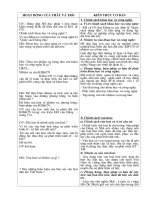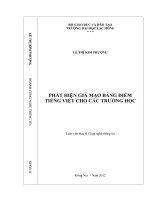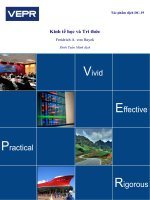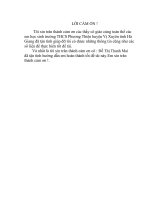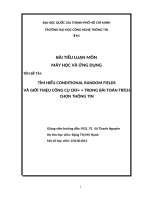Bài giảng Tiếng Anh Unit 4: Natural disasters
Bạn đang xem bản rút gọn của tài liệu. Xem và tải ngay bản đầy đủ của tài liệu tại đây (1.99 MB, 62 trang )
Welcome to our class
1
5
2
4
3
Period: 61
Vocabulary
Unit 9: NATURAL DISASTERS
Lesson 4: Read
- Pacific Rim (n) vành đai Thái Bình Dương
Unit 9:
Natural Disasters
Lesson 3 READ
Period: 61
Vocabulary
Unit 9: NATURAL DISASTERS
Lesson 4: Read
- Pacific Rim (n) vành đai Thái Bình Dương
- collapse (v) sụp đỗ
The buildings
collapse.
Period: 61
Vocabulary
Unit 9: NATURAL DISASTERS
Lesson 4: Read
- Pacific Rim (n) vành đai Thái Bình Dương
- collapse (v) sụp đỗ
tidal wave (n): sóng thần
- abrupt (adj) = suddenđột ngột
Period: 61
Vocabulary
Unit 9: NATURAL DISASTERS
Lesson 4: Read
- Pacific Rim (n) vành đai Thái Bình Dương
- collapse (v) sụp đỗ
tidal wave (n): sóng thần
- abrupt (adj) = suddenđột ngột
hurricane (n) =cyclone =typhoon
Unit 9: NATURAL DISASTERS
Lesson 4: Read
Period: 61
Vocabulary
- Pacific Rim (n) vành đai Thái Bình Dương
- collapse (v) sụp đỗ
tidal wave (n): sóng thần
- abrupt (adj) = suddenđột ngột
hurricane (n) =cyclone =typhoon
-
erupt
(v)
-
>eruption (n)phun, sự phun trào
Period: 61
Vocabulary
Unit 9: NATURAL DISASTERS
Lesson 4: Read
- Pacific Rim (n) vành đai Thái Bình Dương
- collapse (v) sụp đỗ
tidal wave (n): sóng thần
- abrupt (adj) = suddenđột ngột
hurricane (n) =cyclone =typhoon
erupt - >eruption (n)phun, sự phun trào
(v)
tornado (n): lốc xoáy
-
- funnel-shapedcó hình phễu
- suck up (v): hút lên
Period: 61
Vocabulary
Unit 9: NATURAL DISASTERS
Lesson 4: Read
- Pacific Rim (n) vành đai Thái Bình Dương
- collapse (v) sụp đỗ
tidal wave (n): sóng thần
- abrupt (adj) = suddenđột ngột
hurricane (n) =cyclone =typhoon
erupt - >eruption (n)phun, sự phun trào
(v)
tornado (n): lốc xoáy
-
- funnel-shapedcó hình phễu
- suck up (v): hút lên
xe nôi
- baby carriage (n)
Matching
Pacific Rim
có hình phễu
collapse
tidal wave
hút lên
đột ngột
cyclone = typhoon
abrupt
hurricane
erupt
tornado
funnel-shaped
sụp đỗ
1
2
3
4
suck up
baby carriage
5
NATURAL DISASTERS
Earthquakes: Ninety percent of earthquakes occur around the Pacific Rim, which is
known as the ‘Ring of fire’. In 1995, a huge earthquake struck the city of Kobe in
Japan. A large number of people were killed when homes, office blocks and highways
collapsed.
Tidal waves: Tidal waves are the result of an abrupt shift in the underwater
movement of the Earth. In the 1960s, a huge tidal wave were hit Anchorage, Alaska.
The tidal wave traveled from Alaska to California!
Typhoons: When a tropical storm reaches 120 kilometers per hour. It is called a
hurricane in North and South America, a cyclone in Australia, and a typhoon in Asia.
The word ‘typhoon’ comes from Chinese: ‘tai’ means ‘big’ and ‘feng’ means ‘wind’,
so the word ‘typhoon’ means ‘big wind’.
Volcanoes: We can usually predict when a volcano will erupt. Mount Pinatubo,
which is a volcano in the Philippines, erupted in 1991. It was the world’s largest
volcanic eruption in more than 50 years. Hundreds of people died, but thousands were
saved because scientists had warned them about the eruption.
Tornadoes: Tornadoes are funnelshaped storms which pass overland below a
thunderstorm. They can suck up anything that is in their path. In Italy in 1981, a
tornado lifted a baby, who was asleep in its baby carriage, into the air and put it down
safety 100 meters away!
2. True – False:
Guess Answer
1. Most of the earthquakes in the world occur in
the Ring of Fire.
2. The earthquake in Kobe in 1995 caused
severe damage.
3. A huge tidal wave traveled from California to
Alaska and hit Anchorage in the 1960s.
4. Typhoon, hurricane and tropical storm are
different words for the same natural disaster.
5 . The eruption of Mount Pinatubo is the
world's largest ever volcanic eruption.
6. A tornado looks like a funnel.
True or false?
1. Most of the earthquakes in the world
occur in the Ring of Fire.
T
2. The earthquake in Kobe in 1995 caused severe
damage.
T
Earthquakes: Ninety percent of earthquakes occur around
the Pacific Rim, which is known as the ‘Ring of fire’. In
1995, a huge earthquake struck the city of Kobe in Japan. A
large number of people were killed when homes, office
blocks and highways collapsed.
True or false?
3. A huge tidal wave traveled from California
Alaska to
Alaska and hit Anchorage in the 1960s.
California
F
Tidal waves: Tidal waves are the result of an abrupt shift
in the underwater movement of the Earth. In the 1960s, a
huge tidal wave were hit Anchorage, Alaska. The tidal
wave traveled from Alaska to California!
True or false?
4. Typhoon, hurricane and tropical storm are
different words for the same natural disaster.
T
Typhoons: When a tropical storm reaches 120 kilometers per
hour. It is called a hurricane in North and South America, a
cyclone in Australia, and a typhoon in Asia. The word
‘typhoon’ comes from Chinese: ‘tai’ means ‘big’ and ‘feng’
means ‘wind’, so the word ‘typhoon’ means ‘big wind’.
True or false?
5 . The eruption of Mount Pinatubo is the world's
largesteruption
ever volcanic
eruption.
in more
than 50 years
F
Volcanoes: We can usually predict when a volcano will erupt. Mount
Pinatubo, which is a volcano in the Philippines, erupted in 1991. It was
the world’s largest volcanic eruption in more than 50 years. Hundreds
of people died, but thousands were saved because scientists had
warned them about the eruption.
True or false?
6. A tornado looks like a funnel.
F
Tornadoes: Tornadoes are funnelshaped storms which pass
overland below a thunderstorm. They can suck up anything
that is in their path. In Italy in 1981, a tornado lifted a baby,
who was asleep in its baby carriage, into the air and put it
down safety 100 meters away!
2. True – False:
Guess Answer
1. Most of the earthquakes in the world occur in
the Ring of Fire.
T
2. The earthquake in Kobe in 1995 caused
Alaska
severe damage.
T
3. A huge tidal wave traveled from California to
Alaska and hit Anchorage in the 1960s.
California
F
4. Typhoon, hurricane and tropical storm are
different words for the same natural disaster.
T
5 . The eruption of Mount Pinatubo is the
world's largest ever
volcanic
eruption.
eruption
in more than
50 years
F
6. A tornado looks like a funnel.
T
NATURAL DISASTERS
Earthquakes: Ninety percent of earthquakes occur around the Pacific Rim, which is
known as the ‘Ring of fire’. In 1995, a huge earthquake struck the city of Kobe in
Japan. A large number of people were killed when homes, office blocks and highways
collapsed.
Tidal waves: Tidal waves are the result of an abrupt shift in the underwater
movement of the Earth. In the 1960s, a huge tidal wave were hit Anchorage, Alaska.
The tidal wave traveled from Alaska to California!
Typhoons: When a tropical storm reaches 120 kilometers per hour. It is called a
hurricane in North and South America, a cyclone in Australia, and a typhoon in Asia.
The word ‘typhoon’ comes from Chinese: ‘tai’ means ‘big’ and ‘feng’ means ‘wind’,
so the word ‘typhoon’ means ‘big wind’.
Volcanoes: We can usually predict when a volcano will erupt. Mount Pinatubo,
which is a volcano in the Philippines, erupted in 1991. It was the world’s largest
volcanic eruption in more than 50 years. Hundreds of people died, but thousands were
saved because scientists had warned them about the eruption.
Tornadoes: Tornadoes are funnelshaped storms which pass overland below a
thunderstorm. They can suck up anything that is in their path. In Italy in 1981, a
tornado lifted a baby, who was asleep in its baby carriage, into the air and put it down
safety 100 meters away!
Co mple te the s e nte nc e s
1.
The majority of earthquakes…………………………………
2.During the earthquake in Kobe, many………………………...
……………………………………...............................................
3. A tidal wave can only occur when…………………………….
……………………………………………………………………….
4. In Australia, a tropical storm is known as ……………………
5. The Chinese language gave us ………………………………
6. A tornado is a type of storm that ……………………………..
………………………………………………………………………
Co mple te the s e nte nc e s
occur round the Pacific
1. The majority of
Rim
earthquakes…………………………………
people were killed
2.During the earthquake in Kobe,
When
homes,
office
blocks
and
highways
many………………………...
collapsed.
……………………………………......................................
Earthquakes: Ninety percent of earthquakes occur around
.........
the Pacific Rim, which is known as the ‘Ring of fire’. In
1995, a huge earthquake struck the city of Kobe in Japan. A
large number of people were killed when homes, office
blocks and highways collapsed.
Co mple te the s e nte nc e s
there is an abrupt
3. A tidal wave can only occur
when…………………………….
in the underwater movement ofshift
the Earth.
…………………………………………………………
…………….
Tidal waves: Tidal waves are the result of an abrupt shift
in the underwater movement of the Earth. In the 1960s, a
huge tidal wave were hit Anchorage, Alaska. The tidal
wave traveled from Alaska to California!
Co mple te the s e nte nc e s
a cyclone.
4. In Australia, a tropical storm is known as
……………………
the word " typhoon".
5. The Chinese language gave us
Typhoons: When a tropical storm reaches 120 kilometers per hour. It is
………………………………
called a hurricane in North and South America, a cyclone in Australia,
and a typhoon in Asia. The word ‘typhoon’ comes from Chinese: ‘tai’
means ‘big’ and ‘feng’ means ‘wind’, so the word ‘typhoon’ means ‘big
wind’.
Co mple te the s e nte nc e s
passes overland below
6. A tornado is a type of storm that
……………………………..
a
thundderstorm and sucks up anything that is in its
…………………………………………………………
path.
……………
Tornadoes: Tornadoes are funnelshaped storms which pass
overland below a thunderstorm. They can suck up anything
that is in their path. In Italy in 1981, a tornado lifted a baby,
who was asleep in its baby carriage, into the air and put it
down safety 100 meters away!
